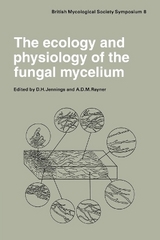
The Ecology and Physiology of the Fungal Mycelium
Cambridge University Press (Verlag)
978-0-521-25413-7 (ISBN)
- Titel erscheint in neuer Auflage
- Artikel merken
Originally published in 1984, this symposium volume, the first of its kind to deal specifically with the vegetative fungal mycelium, includes articles about the pattern of mycelial growth and differentiation, the functioning of mycelia (including nutrient and water uptake), mycelial variation, intermycelial interactions and recognition systems, and the establishment and distribution of mycelia in natural systems. It thus provides a detailed account of the basic body form responsible for the vegetative spread and absorption on nutrients and water. These subjects are clearly of both academic and commercial importance, since fungi make their impact on the environment as symbionts or as decay organisms through the activities of their mycelia.
Contributors; Preface; Nomenclature; 1. The fungal mycelium - and historical perspective P. H. Gregory; 2. Regulation of hyphal branching and hyphal orientation A. P. J. Trinci; 3. Colony ontogeny in basidiomycetes G. M. Butler; 4. Hyphal interactions in Schizophyllum commune: the di-mon mating T. T. Nguyen and D. J. Niderpruem; 5. Hyphal fusion in Coriolus versicolor R. C. Aylmore and N. K. Todd; 6. The mycelial habit and secondary metabolite production M. O. Moss; 7. Water flow through mycelia D. H. Jennings; 8. Morphogenesis of the Serpula lacrimans colony in relation to its functions in nature S. C. Watkinson; 9. Distribution, development and functioning of mycelial cord systems of decomposer basidiomycetes of the deciduous woodland floor W. Thompson; 10. The structure and function of the vegetative mycelium of mycorrhizal roots D. J. Read; 11. Autecology and the mycelium of a woodland litter decomposer J. C. Frankland; 12. The micro-environment of basidiomycete mycelia in temperate deciduous woodlands L. Boddy; 13. Interrelationships between vegetative development and basidiocarp initiation M. Raudaskoski and M. Salonen; 14. Physiology and ecology of rhythmic growth and sporulation in fungi G. Lysek; 15. Senescence in Podospora anerina and its implication for genetic engineering K. Esser, U. Kück, U. Stahl and P. Tudzynski; 16. The mycelial biology of Endothia parasitics. I. nuclear and cytoplasmic genes that determine morphology and virulence S. L. Anagnostakis; 17. Variation and heterokaryosis in Rhizoctonia solani N. A. Anderson; 18. Interspecific mycelial interactions - an overview A. D. M. Rayner and J. F. Webber; 19. Mycelial development and lectin-carbohydrate interactions in nematode-trapping fungi B. Nordbring-Hertz; 20. Mycelial interactions and mitochondrial inheritance in Aspergillus J. H. Croft and R. B. G. Dales; 21. Inter-mycelial recognition systems in Ceratocystis ulmi: their pysiological properties and ecological importance C. M. Brasier; 22. The mycelial biology of Endothia parasitica. II. vegetative incompatibility S. L. Anagnostakis; 23. The biological consequences of individualistic mycelium A. D. M. Rayner, D. Coates, A. M. Ainsworth, T. J. H. Adams, E. N. D. Williams and N. K. Todd; Index of generic and specific names; Subject index.
| Erscheint lt. Verlag | 27.9.1984 |
|---|---|
| Reihe/Serie | British Mycological Society Symposia |
| Verlagsort | Cambridge |
| Sprache | englisch |
| Maße | 152 x 228 mm |
| Gewicht | 1050 g |
| Themenwelt | Naturwissenschaften ► Biologie ► Mikrobiologie / Immunologie |
| ISBN-10 | 0-521-25413-2 / 0521254132 |
| ISBN-13 | 978-0-521-25413-7 / 9780521254137 |
| Zustand | Neuware |
| Haben Sie eine Frage zum Produkt? |
aus dem Bereich



